Brand Management: Significance, Strategy, and Evaluation Report
VerifiedAdded on 2023/01/13
|20
|6064
|75
Report
AI Summary
This report delves into the multifaceted world of brand management, exploring its significance as a marketing tool and its key components. It examines the importance of branding, brand identity, brand meaning, brand response, and brand resonance through Keller's brand equity model. The report analyzes brand strategies, including idea generation, target audience identification, brand promise, brand perception, and brand value. A case study of Samsung illustrates the practical application of these concepts. The report further evaluates techniques for measuring and managing brand value, offering a comprehensive overview of brand management principles and practices, based on a BTEC HND in Business assignment brief.

BRAND MANAGEMENT
Paraphrase This Document
Need a fresh take? Get an instant paraphrase of this document with our AI Paraphraser
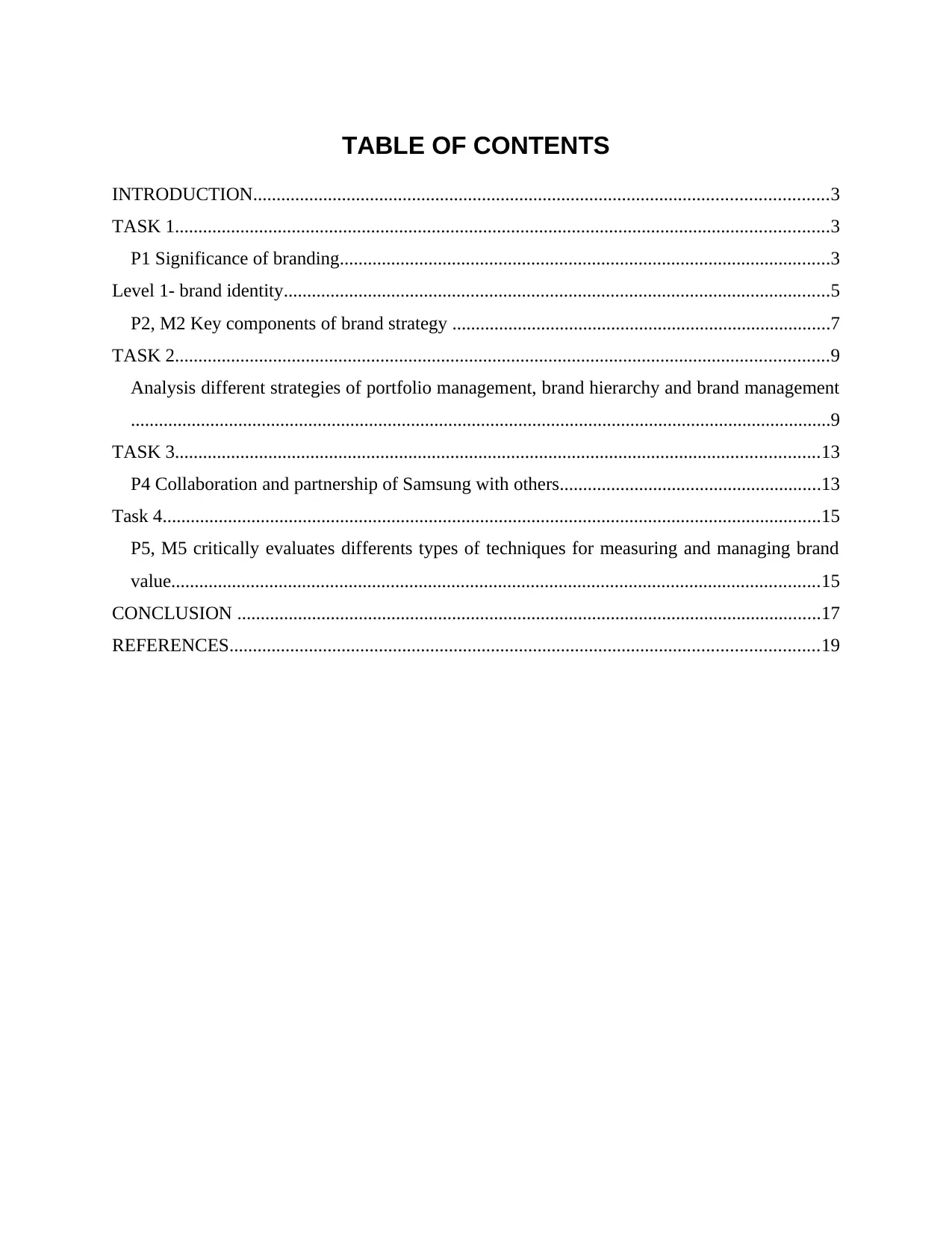
TABLE OF CONTENTS
INTRODUCTION...........................................................................................................................3
TASK 1............................................................................................................................................3
P1 Significance of branding.........................................................................................................3
Level 1- brand identity.....................................................................................................................5
P2, M2 Key components of brand strategy .................................................................................7
TASK 2............................................................................................................................................9
Analysis different strategies of portfolio management, brand hierarchy and brand management
......................................................................................................................................................9
TASK 3..........................................................................................................................................13
P4 Collaboration and partnership of Samsung with others........................................................13
Task 4.............................................................................................................................................15
P5, M5 critically evaluates differents types of techniques for measuring and managing brand
value...........................................................................................................................................15
CONCLUSION .............................................................................................................................17
REFERENCES..............................................................................................................................19
INTRODUCTION...........................................................................................................................3
TASK 1............................................................................................................................................3
P1 Significance of branding.........................................................................................................3
Level 1- brand identity.....................................................................................................................5
P2, M2 Key components of brand strategy .................................................................................7
TASK 2............................................................................................................................................9
Analysis different strategies of portfolio management, brand hierarchy and brand management
......................................................................................................................................................9
TASK 3..........................................................................................................................................13
P4 Collaboration and partnership of Samsung with others........................................................13
Task 4.............................................................................................................................................15
P5, M5 critically evaluates differents types of techniques for measuring and managing brand
value...........................................................................................................................................15
CONCLUSION .............................................................................................................................17
REFERENCES..............................................................................................................................19
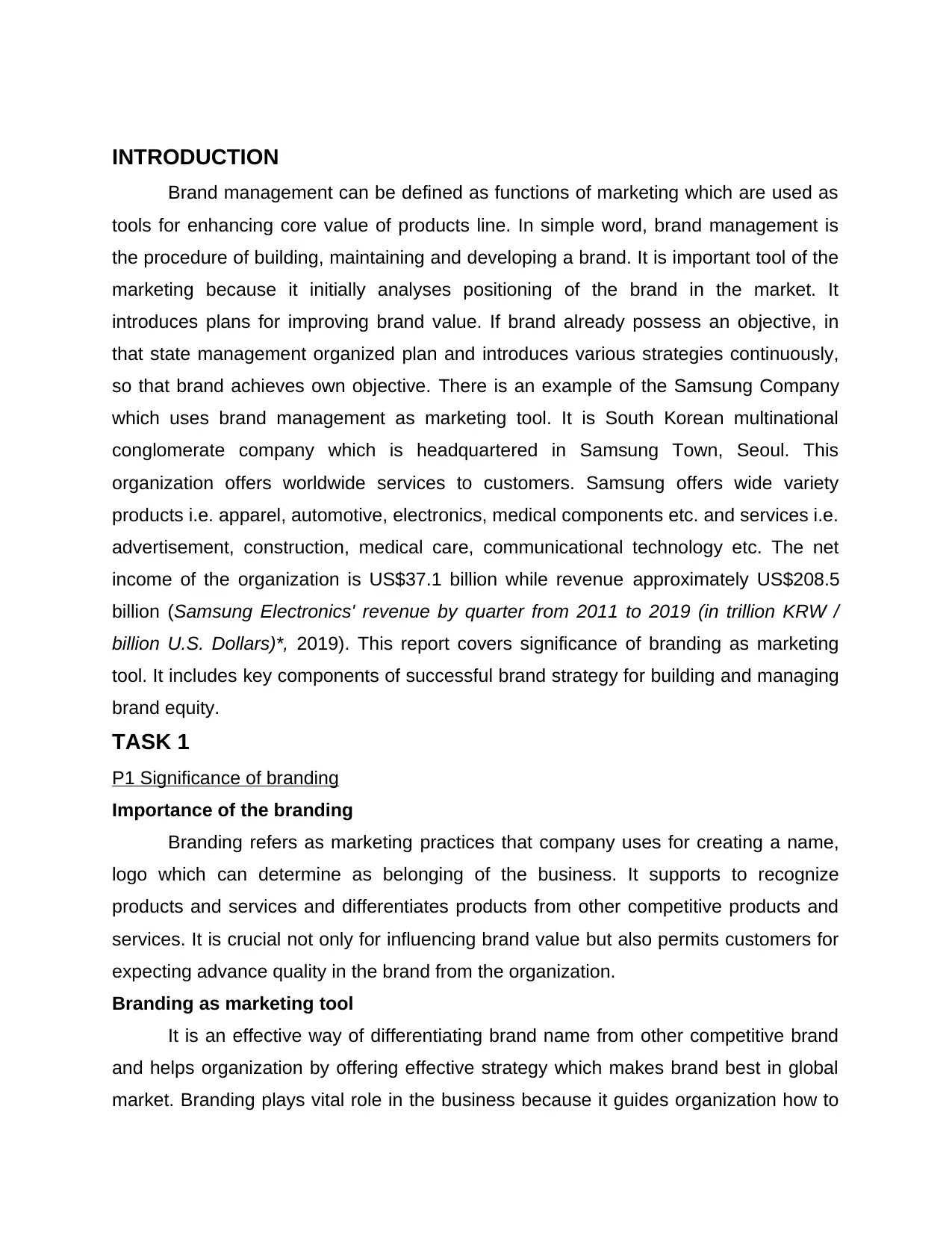
INTRODUCTION
Brand management can be defined as functions of marketing which are used as
tools for enhancing core value of products line. In simple word, brand management is
the procedure of building, maintaining and developing a brand. It is important tool of the
marketing because it initially analyses positioning of the brand in the market. It
introduces plans for improving brand value. If brand already possess an objective, in
that state management organized plan and introduces various strategies continuously,
so that brand achieves own objective. There is an example of the Samsung Company
which uses brand management as marketing tool. It is South Korean multinational
conglomerate company which is headquartered in Samsung Town, Seoul. This
organization offers worldwide services to customers. Samsung offers wide variety
products i.e. apparel, automotive, electronics, medical components etc. and services i.e.
advertisement, construction, medical care, communicational technology etc. The net
income of the organization is US$37.1 billion while revenue approximately US$208.5
billion (Samsung Electronics' revenue by quarter from 2011 to 2019 (in trillion KRW /
billion U.S. Dollars)*, 2019). This report covers significance of branding as marketing
tool. It includes key components of successful brand strategy for building and managing
brand equity.
TASK 1
P1 Significance of branding
Importance of the branding
Branding refers as marketing practices that company uses for creating a name,
logo which can determine as belonging of the business. It supports to recognize
products and services and differentiates products from other competitive products and
services. It is crucial not only for influencing brand value but also permits customers for
expecting advance quality in the brand from the organization.
Branding as marketing tool
It is an effective way of differentiating brand name from other competitive brand
and helps organization by offering effective strategy which makes brand best in global
market. Branding plays vital role in the business because it guides organization how to
Brand management can be defined as functions of marketing which are used as
tools for enhancing core value of products line. In simple word, brand management is
the procedure of building, maintaining and developing a brand. It is important tool of the
marketing because it initially analyses positioning of the brand in the market. It
introduces plans for improving brand value. If brand already possess an objective, in
that state management organized plan and introduces various strategies continuously,
so that brand achieves own objective. There is an example of the Samsung Company
which uses brand management as marketing tool. It is South Korean multinational
conglomerate company which is headquartered in Samsung Town, Seoul. This
organization offers worldwide services to customers. Samsung offers wide variety
products i.e. apparel, automotive, electronics, medical components etc. and services i.e.
advertisement, construction, medical care, communicational technology etc. The net
income of the organization is US$37.1 billion while revenue approximately US$208.5
billion (Samsung Electronics' revenue by quarter from 2011 to 2019 (in trillion KRW /
billion U.S. Dollars)*, 2019). This report covers significance of branding as marketing
tool. It includes key components of successful brand strategy for building and managing
brand equity.
TASK 1
P1 Significance of branding
Importance of the branding
Branding refers as marketing practices that company uses for creating a name,
logo which can determine as belonging of the business. It supports to recognize
products and services and differentiates products from other competitive products and
services. It is crucial not only for influencing brand value but also permits customers for
expecting advance quality in the brand from the organization.
Branding as marketing tool
It is an effective way of differentiating brand name from other competitive brand
and helps organization by offering effective strategy which makes brand best in global
market. Branding plays vital role in the business because it guides organization how to
⊘ This is a preview!⊘
Do you want full access?
Subscribe today to unlock all pages.

Trusted by 1+ million students worldwide
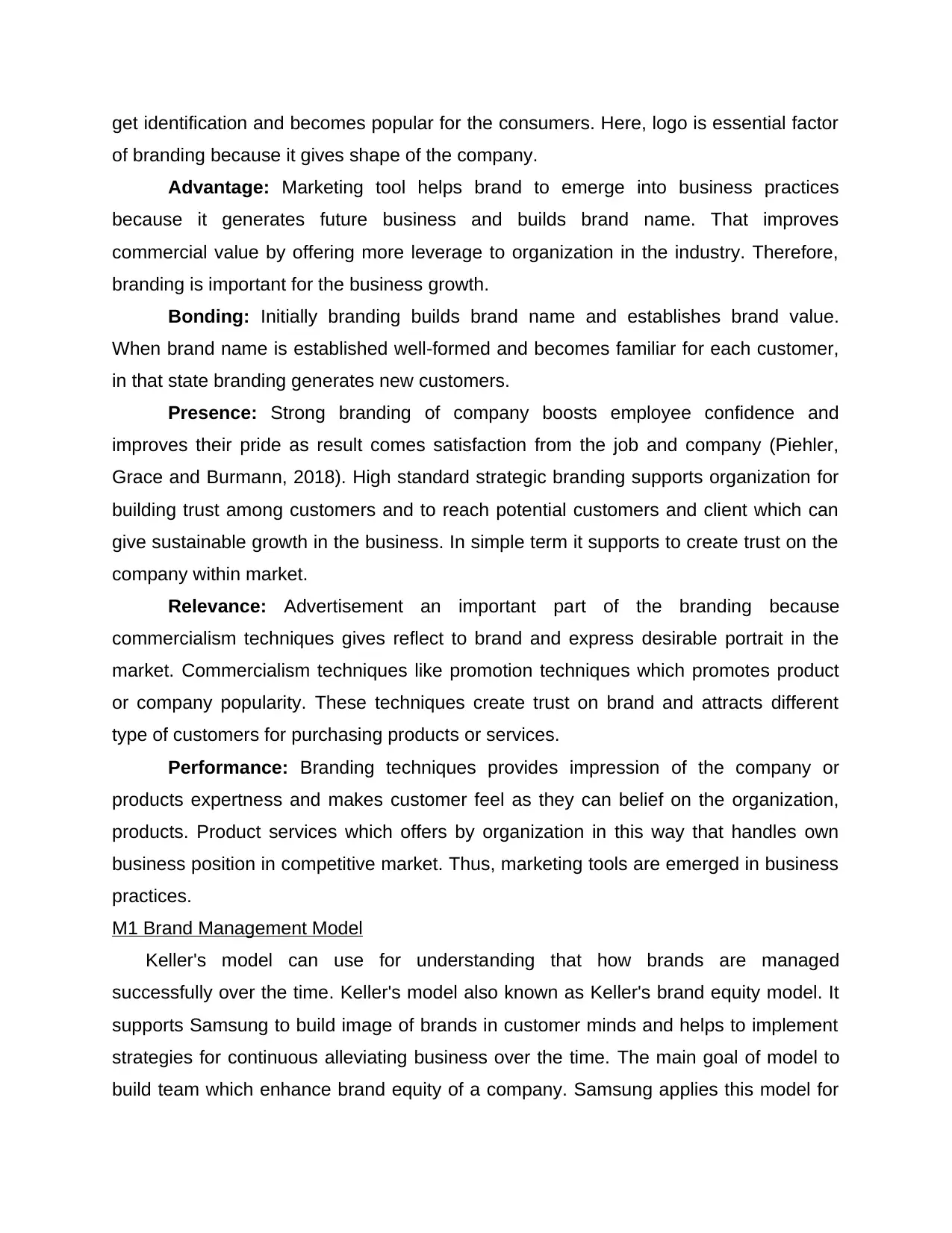
get identification and becomes popular for the consumers. Here, logo is essential factor
of branding because it gives shape of the company.
Advantage: Marketing tool helps brand to emerge into business practices
because it generates future business and builds brand name. That improves
commercial value by offering more leverage to organization in the industry. Therefore,
branding is important for the business growth.
Bonding: Initially branding builds brand name and establishes brand value.
When brand name is established well-formed and becomes familiar for each customer,
in that state branding generates new customers.
Presence: Strong branding of company boosts employee confidence and
improves their pride as result comes satisfaction from the job and company (Piehler,
Grace and Burmann, 2018). High standard strategic branding supports organization for
building trust among customers and to reach potential customers and client which can
give sustainable growth in the business. In simple term it supports to create trust on the
company within market.
Relevance: Advertisement an important part of the branding because
commercialism techniques gives reflect to brand and express desirable portrait in the
market. Commercialism techniques like promotion techniques which promotes product
or company popularity. These techniques create trust on brand and attracts different
type of customers for purchasing products or services.
Performance: Branding techniques provides impression of the company or
products expertness and makes customer feel as they can belief on the organization,
products. Product services which offers by organization in this way that handles own
business position in competitive market. Thus, marketing tools are emerged in business
practices.
M1 Brand Management Model
Keller's model can use for understanding that how brands are managed
successfully over the time. Keller's model also known as Keller's brand equity model. It
supports Samsung to build image of brands in customer minds and helps to implement
strategies for continuous alleviating business over the time. The main goal of model to
build team which enhance brand equity of a company. Samsung applies this model for
of branding because it gives shape of the company.
Advantage: Marketing tool helps brand to emerge into business practices
because it generates future business and builds brand name. That improves
commercial value by offering more leverage to organization in the industry. Therefore,
branding is important for the business growth.
Bonding: Initially branding builds brand name and establishes brand value.
When brand name is established well-formed and becomes familiar for each customer,
in that state branding generates new customers.
Presence: Strong branding of company boosts employee confidence and
improves their pride as result comes satisfaction from the job and company (Piehler,
Grace and Burmann, 2018). High standard strategic branding supports organization for
building trust among customers and to reach potential customers and client which can
give sustainable growth in the business. In simple term it supports to create trust on the
company within market.
Relevance: Advertisement an important part of the branding because
commercialism techniques gives reflect to brand and express desirable portrait in the
market. Commercialism techniques like promotion techniques which promotes product
or company popularity. These techniques create trust on brand and attracts different
type of customers for purchasing products or services.
Performance: Branding techniques provides impression of the company or
products expertness and makes customer feel as they can belief on the organization,
products. Product services which offers by organization in this way that handles own
business position in competitive market. Thus, marketing tools are emerged in business
practices.
M1 Brand Management Model
Keller's model can use for understanding that how brands are managed
successfully over the time. Keller's model also known as Keller's brand equity model. It
supports Samsung to build image of brands in customer minds and helps to implement
strategies for continuous alleviating business over the time. The main goal of model to
build team which enhance brand equity of a company. Samsung applies this model for
Paraphrase This Document
Need a fresh take? Get an instant paraphrase of this document with our AI Paraphraser

managing brand equity over the time. This model is elaborated into brand equity
pyramid which is classified into four levels such as-
Level 1- brand identity
Brand identity can be defined as visual element of the brand i.e. colour, design,
logo, packaging which is identity of brand and differentiates the brand in the mind of
customers. In simple words, brand identity is well-defined image of the brand. To make
brand familiar of customer requires building brand identity. Brand identity is the primary
step in Keller's model which is most important step because it prepares platform of the
brand. Brand identity assists company to influence brand awareness in customers and
distinguish product from other products. To introduce new brand in market, Samsung
uses slogan or message for influencing brand awareness.
Level-2 Brand Meaning
It is second step of the Keller's brand equity model which gives carve to brand
and defines meaning of the brand as result for building brand loyalty within public.
Brand meaning not only express brand quality, price which is offered by the company
but also leads brand establishment within market (Borkovsky and et.al., 2017).
Organization builds meaning of the brand by number of different things such as giving
loyalty, claiming of 100% guarantee for product quality and commitment for audience
services. The main goal of the brand meaning to provide reason of the public of their
purchasing so that they come to visit again. Samsung company claims about electronic
quality which differentiate company from other. Thus brand meaning leads brand
performance and brand image in market which pulls customer towards company for
buying products.
Level-3 Brand Response
When products are purchased by the customers, they build their expectation with
the company for the brand so that they get reason to come back again for the products.
For example, if organization meets their expectation and offers highly featured product
to customers that means customer is totally attached with the company and
organization gets opportunity to grow business and gets success. On the other hand, if
organization unable to meet their expectation that leads negative response of the
customers i.e. doesn't purchase products and break trust on brand. Due to bad
pyramid which is classified into four levels such as-
Level 1- brand identity
Brand identity can be defined as visual element of the brand i.e. colour, design,
logo, packaging which is identity of brand and differentiates the brand in the mind of
customers. In simple words, brand identity is well-defined image of the brand. To make
brand familiar of customer requires building brand identity. Brand identity is the primary
step in Keller's model which is most important step because it prepares platform of the
brand. Brand identity assists company to influence brand awareness in customers and
distinguish product from other products. To introduce new brand in market, Samsung
uses slogan or message for influencing brand awareness.
Level-2 Brand Meaning
It is second step of the Keller's brand equity model which gives carve to brand
and defines meaning of the brand as result for building brand loyalty within public.
Brand meaning not only express brand quality, price which is offered by the company
but also leads brand establishment within market (Borkovsky and et.al., 2017).
Organization builds meaning of the brand by number of different things such as giving
loyalty, claiming of 100% guarantee for product quality and commitment for audience
services. The main goal of the brand meaning to provide reason of the public of their
purchasing so that they come to visit again. Samsung company claims about electronic
quality which differentiate company from other. Thus brand meaning leads brand
performance and brand image in market which pulls customer towards company for
buying products.
Level-3 Brand Response
When products are purchased by the customers, they build their expectation with
the company for the brand so that they get reason to come back again for the products.
For example, if organization meets their expectation and offers highly featured product
to customers that means customer is totally attached with the company and
organization gets opportunity to grow business and gets success. On the other hand, if
organization unable to meet their expectation that leads negative response of the
customers i.e. doesn't purchase products and break trust on brand. Due to bad
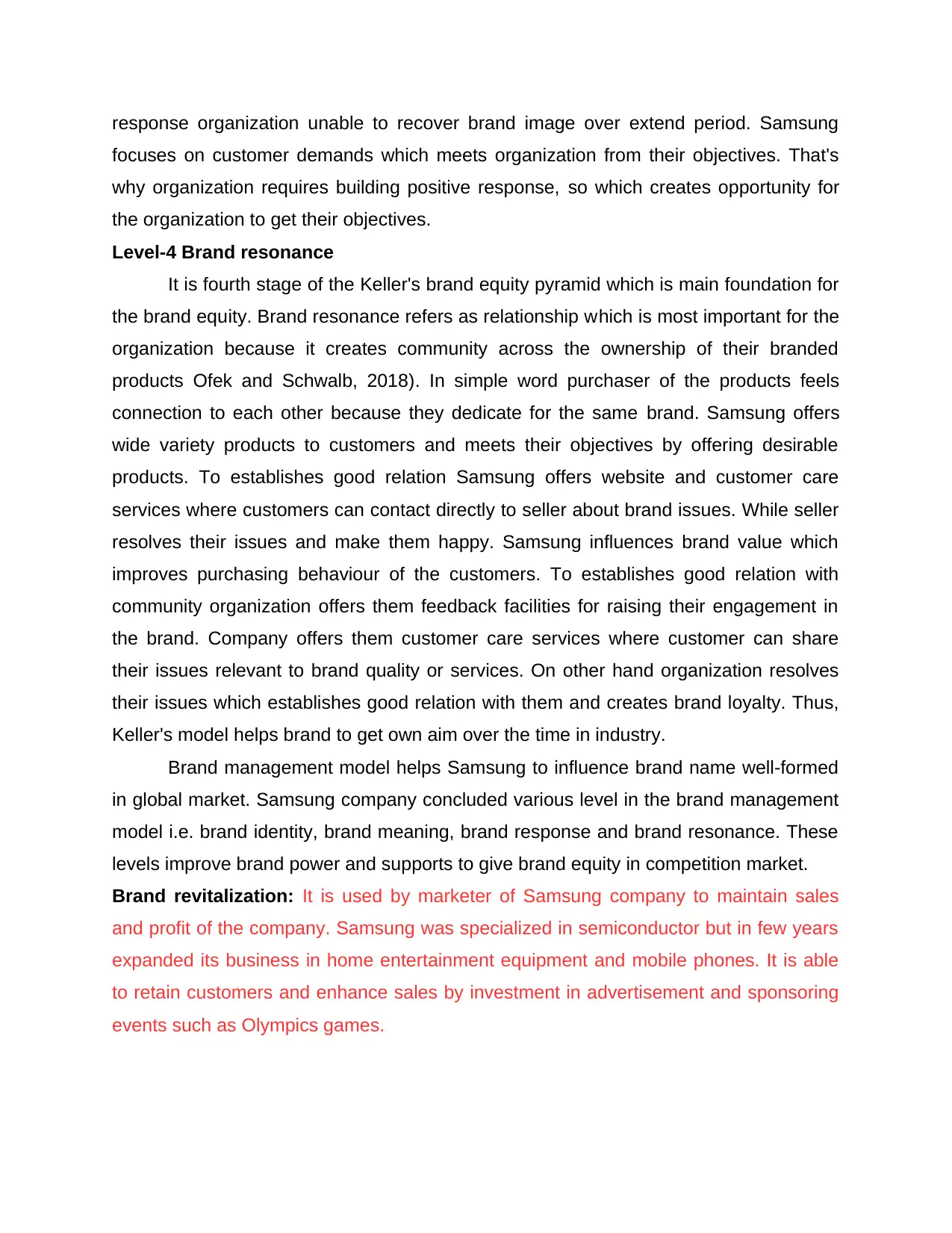
response organization unable to recover brand image over extend period. Samsung
focuses on customer demands which meets organization from their objectives. That's
why organization requires building positive response, so which creates opportunity for
the organization to get their objectives.
Level-4 Brand resonance
It is fourth stage of the Keller's brand equity pyramid which is main foundation for
the brand equity. Brand resonance refers as relationship which is most important for the
organization because it creates community across the ownership of their branded
products Ofek and Schwalb, 2018). In simple word purchaser of the products feels
connection to each other because they dedicate for the same brand. Samsung offers
wide variety products to customers and meets their objectives by offering desirable
products. To establishes good relation Samsung offers website and customer care
services where customers can contact directly to seller about brand issues. While seller
resolves their issues and make them happy. Samsung influences brand value which
improves purchasing behaviour of the customers. To establishes good relation with
community organization offers them feedback facilities for raising their engagement in
the brand. Company offers them customer care services where customer can share
their issues relevant to brand quality or services. On other hand organization resolves
their issues which establishes good relation with them and creates brand loyalty. Thus,
Keller's model helps brand to get own aim over the time in industry.
Brand management model helps Samsung to influence brand name well-formed
in global market. Samsung company concluded various level in the brand management
model i.e. brand identity, brand meaning, brand response and brand resonance. These
levels improve brand power and supports to give brand equity in competition market.
Brand revitalization: It is used by marketer of Samsung company to maintain sales
and profit of the company. Samsung was specialized in semiconductor but in few years
expanded its business in home entertainment equipment and mobile phones. It is able
to retain customers and enhance sales by investment in advertisement and sponsoring
events such as Olympics games.
focuses on customer demands which meets organization from their objectives. That's
why organization requires building positive response, so which creates opportunity for
the organization to get their objectives.
Level-4 Brand resonance
It is fourth stage of the Keller's brand equity pyramid which is main foundation for
the brand equity. Brand resonance refers as relationship which is most important for the
organization because it creates community across the ownership of their branded
products Ofek and Schwalb, 2018). In simple word purchaser of the products feels
connection to each other because they dedicate for the same brand. Samsung offers
wide variety products to customers and meets their objectives by offering desirable
products. To establishes good relation Samsung offers website and customer care
services where customers can contact directly to seller about brand issues. While seller
resolves their issues and make them happy. Samsung influences brand value which
improves purchasing behaviour of the customers. To establishes good relation with
community organization offers them feedback facilities for raising their engagement in
the brand. Company offers them customer care services where customer can share
their issues relevant to brand quality or services. On other hand organization resolves
their issues which establishes good relation with them and creates brand loyalty. Thus,
Keller's model helps brand to get own aim over the time in industry.
Brand management model helps Samsung to influence brand name well-formed
in global market. Samsung company concluded various level in the brand management
model i.e. brand identity, brand meaning, brand response and brand resonance. These
levels improve brand power and supports to give brand equity in competition market.
Brand revitalization: It is used by marketer of Samsung company to maintain sales
and profit of the company. Samsung was specialized in semiconductor but in few years
expanded its business in home entertainment equipment and mobile phones. It is able
to retain customers and enhance sales by investment in advertisement and sponsoring
events such as Olympics games.
⊘ This is a preview!⊘
Do you want full access?
Subscribe today to unlock all pages.

Trusted by 1+ million students worldwide
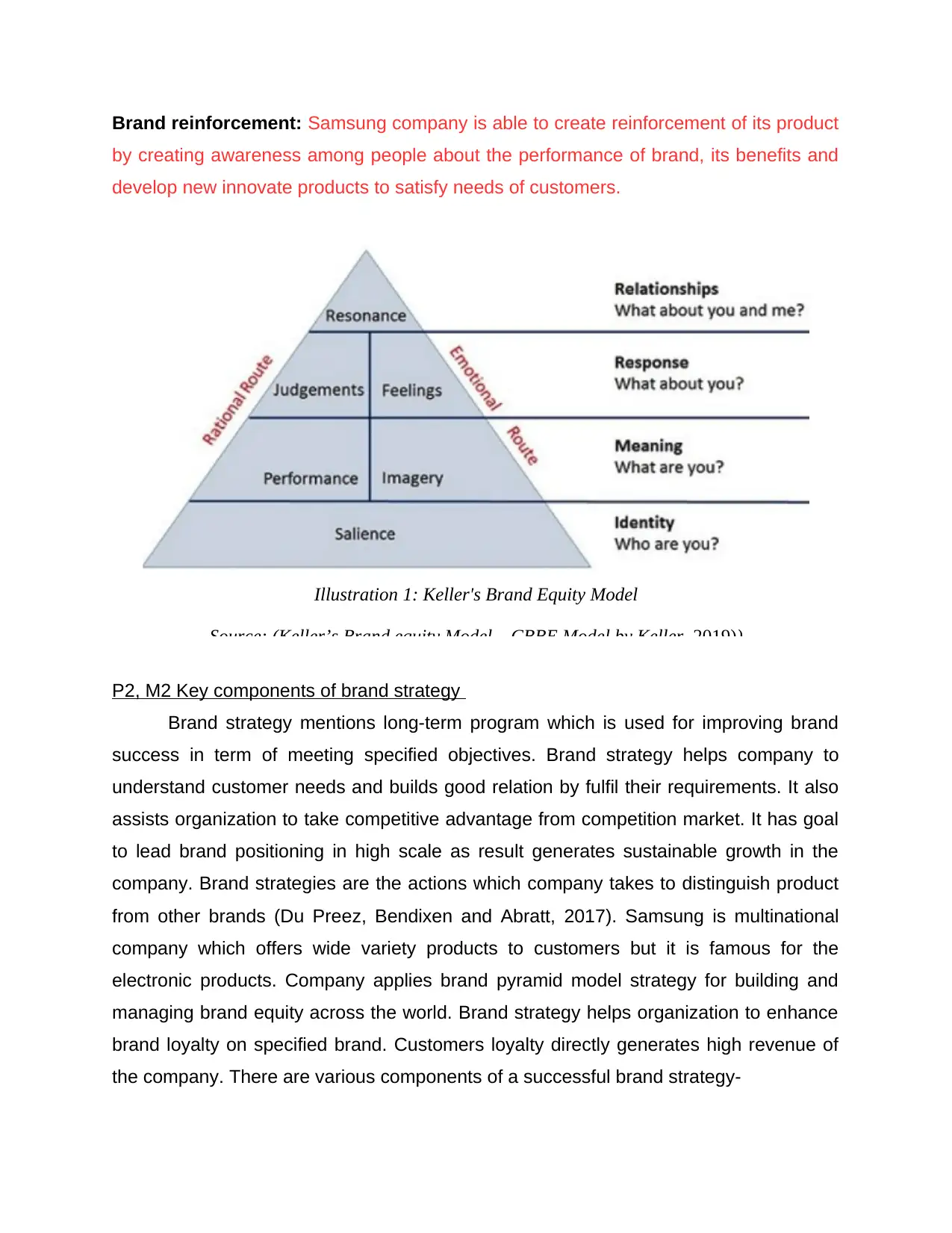
Brand reinforcement: Samsung company is able to create reinforcement of its product
by creating awareness among people about the performance of brand, its benefits and
develop new innovate products to satisfy needs of customers.
P2, M2 Key components of brand strategy
Brand strategy mentions long-term program which is used for improving brand
success in term of meeting specified objectives. Brand strategy helps company to
understand customer needs and builds good relation by fulfil their requirements. It also
assists organization to take competitive advantage from competition market. It has goal
to lead brand positioning in high scale as result generates sustainable growth in the
company. Brand strategies are the actions which company takes to distinguish product
from other brands (Du Preez, Bendixen and Abratt, 2017). Samsung is multinational
company which offers wide variety products to customers but it is famous for the
electronic products. Company applies brand pyramid model strategy for building and
managing brand equity across the world. Brand strategy helps organization to enhance
brand loyalty on specified brand. Customers loyalty directly generates high revenue of
the company. There are various components of a successful brand strategy-
Illustration 1: Keller's Brand Equity Model
Source: (Keller’s Brand equity Model – CBBE Model by Keller, 2019))
by creating awareness among people about the performance of brand, its benefits and
develop new innovate products to satisfy needs of customers.
P2, M2 Key components of brand strategy
Brand strategy mentions long-term program which is used for improving brand
success in term of meeting specified objectives. Brand strategy helps company to
understand customer needs and builds good relation by fulfil their requirements. It also
assists organization to take competitive advantage from competition market. It has goal
to lead brand positioning in high scale as result generates sustainable growth in the
company. Brand strategies are the actions which company takes to distinguish product
from other brands (Du Preez, Bendixen and Abratt, 2017). Samsung is multinational
company which offers wide variety products to customers but it is famous for the
electronic products. Company applies brand pyramid model strategy for building and
managing brand equity across the world. Brand strategy helps organization to enhance
brand loyalty on specified brand. Customers loyalty directly generates high revenue of
the company. There are various components of a successful brand strategy-
Illustration 1: Keller's Brand Equity Model
Source: (Keller’s Brand equity Model – CBBE Model by Keller, 2019))
Paraphrase This Document
Need a fresh take? Get an instant paraphrase of this document with our AI Paraphraser
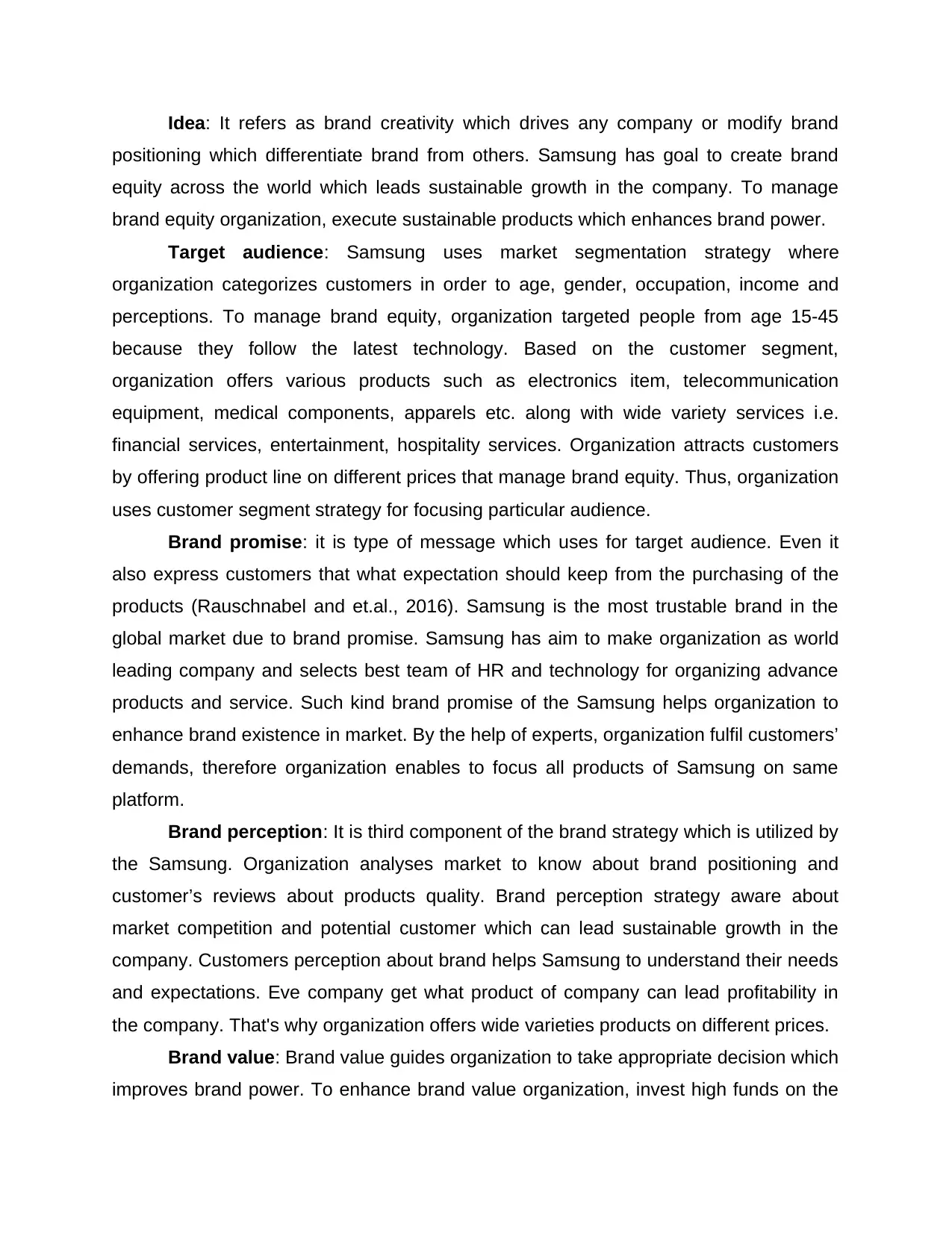
Idea: It refers as brand creativity which drives any company or modify brand
positioning which differentiate brand from others. Samsung has goal to create brand
equity across the world which leads sustainable growth in the company. To manage
brand equity organization, execute sustainable products which enhances brand power.
Target audience: Samsung uses market segmentation strategy where
organization categorizes customers in order to age, gender, occupation, income and
perceptions. To manage brand equity, organization targeted people from age 15-45
because they follow the latest technology. Based on the customer segment,
organization offers various products such as electronics item, telecommunication
equipment, medical components, apparels etc. along with wide variety services i.e.
financial services, entertainment, hospitality services. Organization attracts customers
by offering product line on different prices that manage brand equity. Thus, organization
uses customer segment strategy for focusing particular audience.
Brand promise: it is type of message which uses for target audience. Even it
also express customers that what expectation should keep from the purchasing of the
products (Rauschnabel and et.al., 2016). Samsung is the most trustable brand in the
global market due to brand promise. Samsung has aim to make organization as world
leading company and selects best team of HR and technology for organizing advance
products and service. Such kind brand promise of the Samsung helps organization to
enhance brand existence in market. By the help of experts, organization fulfil customers’
demands, therefore organization enables to focus all products of Samsung on same
platform.
Brand perception: It is third component of the brand strategy which is utilized by
the Samsung. Organization analyses market to know about brand positioning and
customer’s reviews about products quality. Brand perception strategy aware about
market competition and potential customer which can lead sustainable growth in the
company. Customers perception about brand helps Samsung to understand their needs
and expectations. Eve company get what product of company can lead profitability in
the company. That's why organization offers wide varieties products on different prices.
Brand value: Brand value guides organization to take appropriate decision which
improves brand power. To enhance brand value organization, invest high funds on the
positioning which differentiate brand from others. Samsung has goal to create brand
equity across the world which leads sustainable growth in the company. To manage
brand equity organization, execute sustainable products which enhances brand power.
Target audience: Samsung uses market segmentation strategy where
organization categorizes customers in order to age, gender, occupation, income and
perceptions. To manage brand equity, organization targeted people from age 15-45
because they follow the latest technology. Based on the customer segment,
organization offers various products such as electronics item, telecommunication
equipment, medical components, apparels etc. along with wide variety services i.e.
financial services, entertainment, hospitality services. Organization attracts customers
by offering product line on different prices that manage brand equity. Thus, organization
uses customer segment strategy for focusing particular audience.
Brand promise: it is type of message which uses for target audience. Even it
also express customers that what expectation should keep from the purchasing of the
products (Rauschnabel and et.al., 2016). Samsung is the most trustable brand in the
global market due to brand promise. Samsung has aim to make organization as world
leading company and selects best team of HR and technology for organizing advance
products and service. Such kind brand promise of the Samsung helps organization to
enhance brand existence in market. By the help of experts, organization fulfil customers’
demands, therefore organization enables to focus all products of Samsung on same
platform.
Brand perception: It is third component of the brand strategy which is utilized by
the Samsung. Organization analyses market to know about brand positioning and
customer’s reviews about products quality. Brand perception strategy aware about
market competition and potential customer which can lead sustainable growth in the
company. Customers perception about brand helps Samsung to understand their needs
and expectations. Eve company get what product of company can lead profitability in
the company. That's why organization offers wide varieties products on different prices.
Brand value: Brand value guides organization to take appropriate decision which
improves brand power. To enhance brand value organization, invest high funds on the
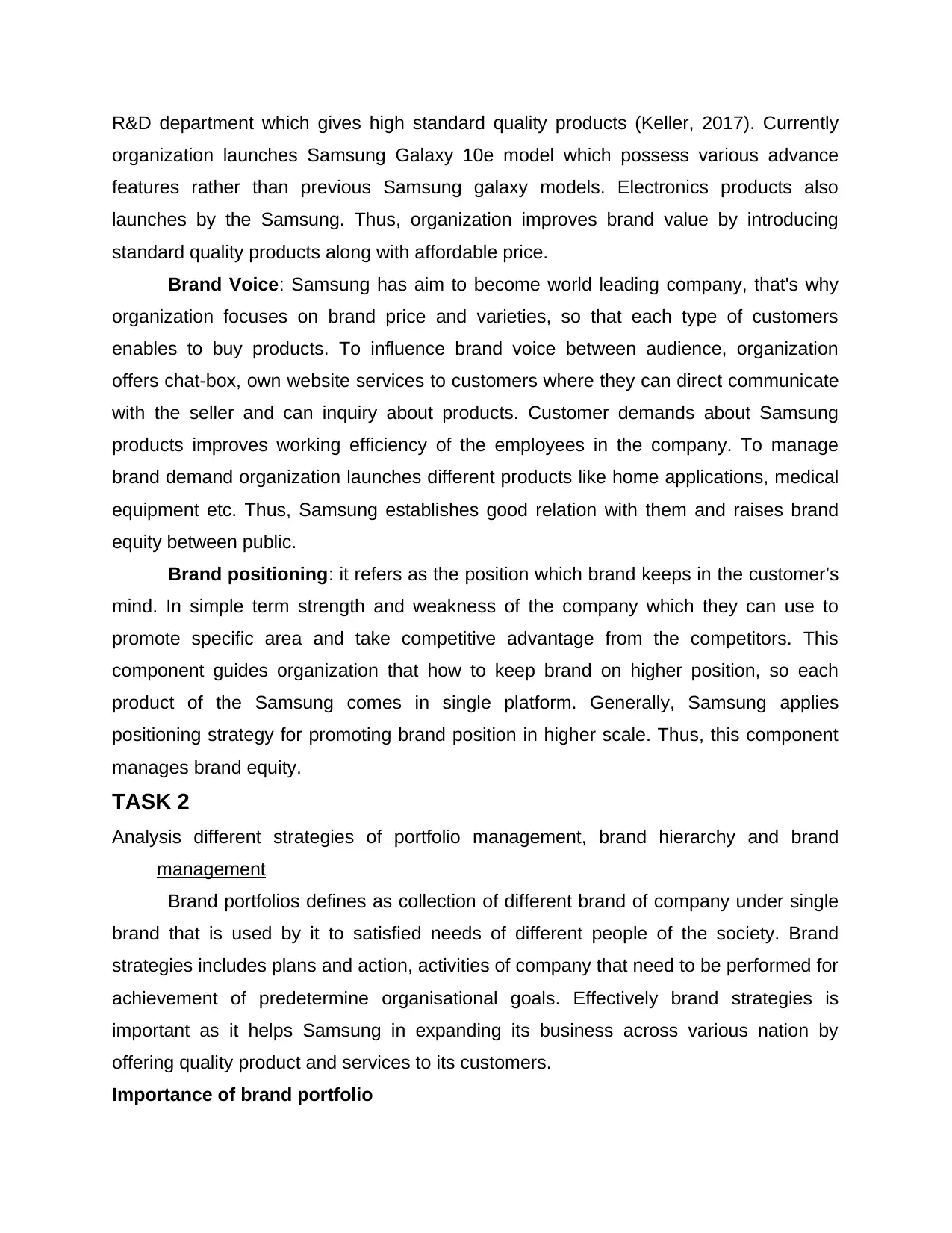
R&D department which gives high standard quality products (Keller, 2017). Currently
organization launches Samsung Galaxy 10e model which possess various advance
features rather than previous Samsung galaxy models. Electronics products also
launches by the Samsung. Thus, organization improves brand value by introducing
standard quality products along with affordable price.
Brand Voice: Samsung has aim to become world leading company, that's why
organization focuses on brand price and varieties, so that each type of customers
enables to buy products. To influence brand voice between audience, organization
offers chat-box, own website services to customers where they can direct communicate
with the seller and can inquiry about products. Customer demands about Samsung
products improves working efficiency of the employees in the company. To manage
brand demand organization launches different products like home applications, medical
equipment etc. Thus, Samsung establishes good relation with them and raises brand
equity between public.
Brand positioning: it refers as the position which brand keeps in the customer’s
mind. In simple term strength and weakness of the company which they can use to
promote specific area and take competitive advantage from the competitors. This
component guides organization that how to keep brand on higher position, so each
product of the Samsung comes in single platform. Generally, Samsung applies
positioning strategy for promoting brand position in higher scale. Thus, this component
manages brand equity.
TASK 2
Analysis different strategies of portfolio management, brand hierarchy and brand
management
Brand portfolios defines as collection of different brand of company under single
brand that is used by it to satisfied needs of different people of the society. Brand
strategies includes plans and action, activities of company that need to be performed for
achievement of predetermine organisational goals. Effectively brand strategies is
important as it helps Samsung in expanding its business across various nation by
offering quality product and services to its customers.
Importance of brand portfolio
organization launches Samsung Galaxy 10e model which possess various advance
features rather than previous Samsung galaxy models. Electronics products also
launches by the Samsung. Thus, organization improves brand value by introducing
standard quality products along with affordable price.
Brand Voice: Samsung has aim to become world leading company, that's why
organization focuses on brand price and varieties, so that each type of customers
enables to buy products. To influence brand voice between audience, organization
offers chat-box, own website services to customers where they can direct communicate
with the seller and can inquiry about products. Customer demands about Samsung
products improves working efficiency of the employees in the company. To manage
brand demand organization launches different products like home applications, medical
equipment etc. Thus, Samsung establishes good relation with them and raises brand
equity between public.
Brand positioning: it refers as the position which brand keeps in the customer’s
mind. In simple term strength and weakness of the company which they can use to
promote specific area and take competitive advantage from the competitors. This
component guides organization that how to keep brand on higher position, so each
product of the Samsung comes in single platform. Generally, Samsung applies
positioning strategy for promoting brand position in higher scale. Thus, this component
manages brand equity.
TASK 2
Analysis different strategies of portfolio management, brand hierarchy and brand
management
Brand portfolios defines as collection of different brand of company under single
brand that is used by it to satisfied needs of different people of the society. Brand
strategies includes plans and action, activities of company that need to be performed for
achievement of predetermine organisational goals. Effectively brand strategies is
important as it helps Samsung in expanding its business across various nation by
offering quality product and services to its customers.
Importance of brand portfolio
⊘ This is a preview!⊘
Do you want full access?
Subscribe today to unlock all pages.

Trusted by 1+ million students worldwide
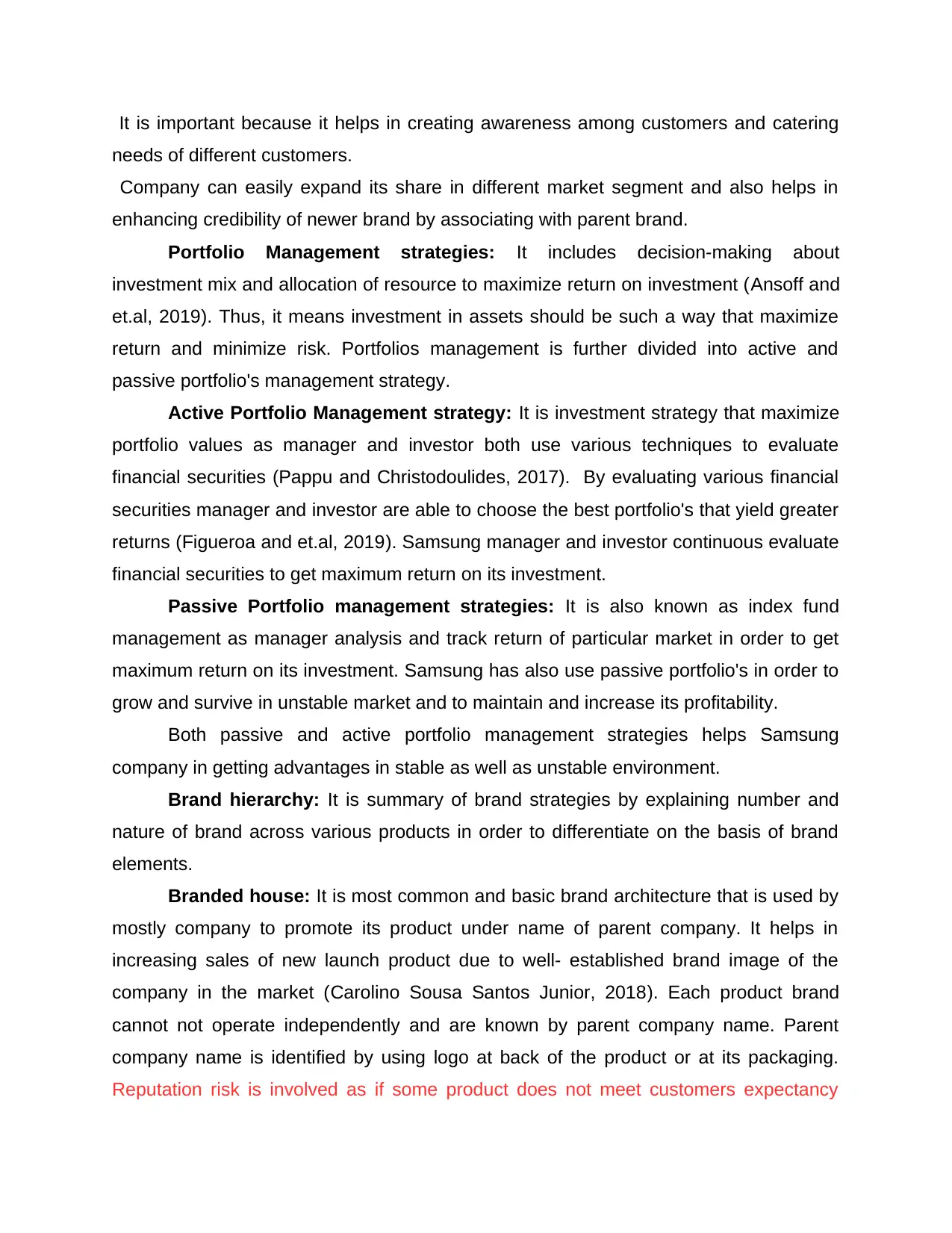
It is important because it helps in creating awareness among customers and catering
needs of different customers.
Company can easily expand its share in different market segment and also helps in
enhancing credibility of newer brand by associating with parent brand.
Portfolio Management strategies: It includes decision-making about
investment mix and allocation of resource to maximize return on investment (Ansoff and
et.al, 2019). Thus, it means investment in assets should be such a way that maximize
return and minimize risk. Portfolios management is further divided into active and
passive portfolio's management strategy.
Active Portfolio Management strategy: It is investment strategy that maximize
portfolio values as manager and investor both use various techniques to evaluate
financial securities (Pappu and Christodoulides, 2017). By evaluating various financial
securities manager and investor are able to choose the best portfolio's that yield greater
returns (Figueroa and et.al, 2019). Samsung manager and investor continuous evaluate
financial securities to get maximum return on its investment.
Passive Portfolio management strategies: It is also known as index fund
management as manager analysis and track return of particular market in order to get
maximum return on its investment. Samsung has also use passive portfolio's in order to
grow and survive in unstable market and to maintain and increase its profitability.
Both passive and active portfolio management strategies helps Samsung
company in getting advantages in stable as well as unstable environment.
Brand hierarchy: It is summary of brand strategies by explaining number and
nature of brand across various products in order to differentiate on the basis of brand
elements.
Branded house: It is most common and basic brand architecture that is used by
mostly company to promote its product under name of parent company. It helps in
increasing sales of new launch product due to well- established brand image of the
company in the market (Carolino Sousa Santos Junior, 2018). Each product brand
cannot not operate independently and are known by parent company name. Parent
company name is identified by using logo at back of the product or at its packaging.
Reputation risk is involved as if some product does not meet customers expectancy
needs of different customers.
Company can easily expand its share in different market segment and also helps in
enhancing credibility of newer brand by associating with parent brand.
Portfolio Management strategies: It includes decision-making about
investment mix and allocation of resource to maximize return on investment (Ansoff and
et.al, 2019). Thus, it means investment in assets should be such a way that maximize
return and minimize risk. Portfolios management is further divided into active and
passive portfolio's management strategy.
Active Portfolio Management strategy: It is investment strategy that maximize
portfolio values as manager and investor both use various techniques to evaluate
financial securities (Pappu and Christodoulides, 2017). By evaluating various financial
securities manager and investor are able to choose the best portfolio's that yield greater
returns (Figueroa and et.al, 2019). Samsung manager and investor continuous evaluate
financial securities to get maximum return on its investment.
Passive Portfolio management strategies: It is also known as index fund
management as manager analysis and track return of particular market in order to get
maximum return on its investment. Samsung has also use passive portfolio's in order to
grow and survive in unstable market and to maintain and increase its profitability.
Both passive and active portfolio management strategies helps Samsung
company in getting advantages in stable as well as unstable environment.
Brand hierarchy: It is summary of brand strategies by explaining number and
nature of brand across various products in order to differentiate on the basis of brand
elements.
Branded house: It is most common and basic brand architecture that is used by
mostly company to promote its product under name of parent company. It helps in
increasing sales of new launch product due to well- established brand image of the
company in the market (Carolino Sousa Santos Junior, 2018). Each product brand
cannot not operate independently and are known by parent company name. Parent
company name is identified by using logo at back of the product or at its packaging.
Reputation risk is involved as if some product does not meet customers expectancy
Paraphrase This Document
Need a fresh take? Get an instant paraphrase of this document with our AI Paraphraser
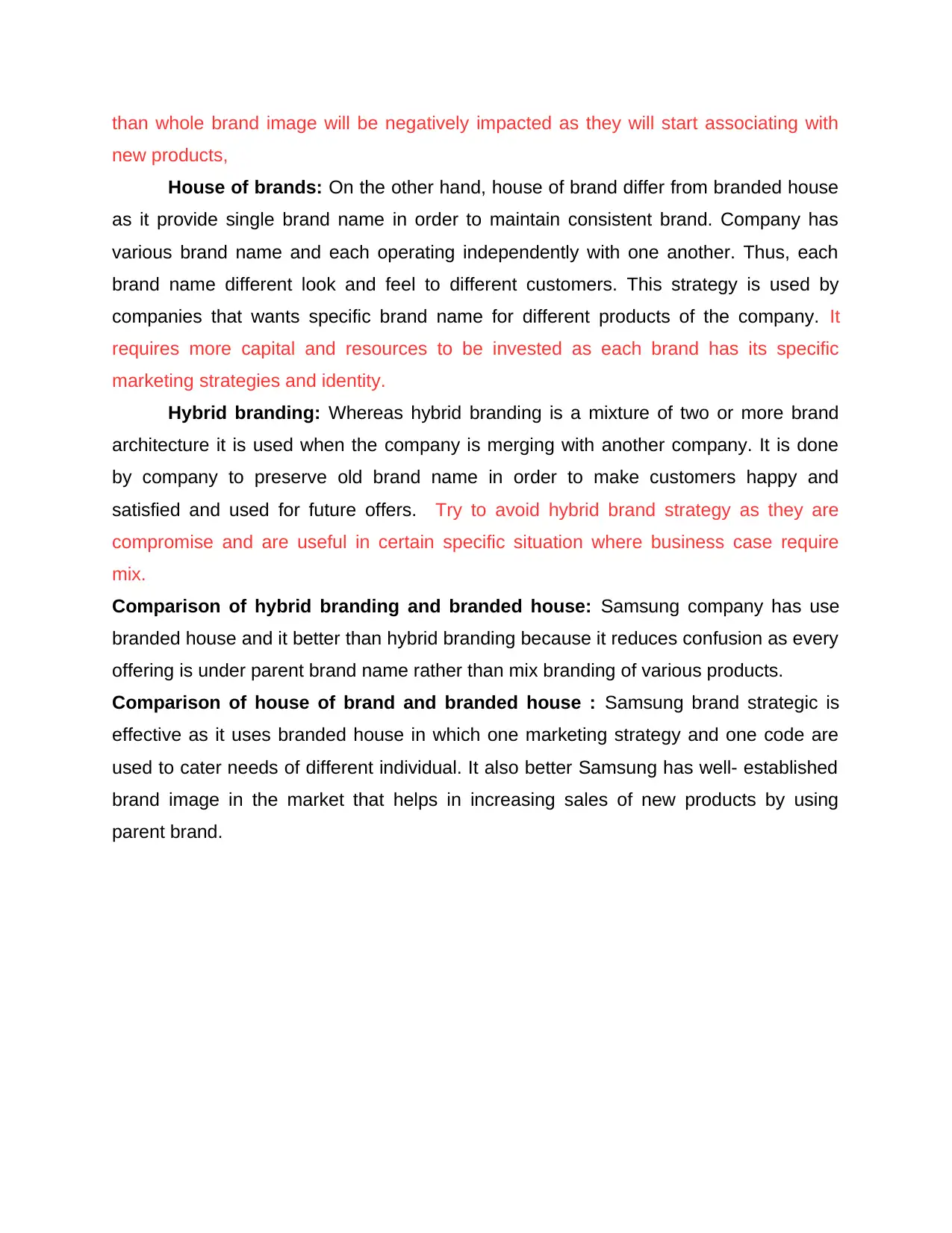
than whole brand image will be negatively impacted as they will start associating with
new products,
House of brands: On the other hand, house of brand differ from branded house
as it provide single brand name in order to maintain consistent brand. Company has
various brand name and each operating independently with one another. Thus, each
brand name different look and feel to different customers. This strategy is used by
companies that wants specific brand name for different products of the company. It
requires more capital and resources to be invested as each brand has its specific
marketing strategies and identity.
Hybrid branding: Whereas hybrid branding is a mixture of two or more brand
architecture it is used when the company is merging with another company. It is done
by company to preserve old brand name in order to make customers happy and
satisfied and used for future offers. Try to avoid hybrid brand strategy as they are
compromise and are useful in certain specific situation where business case require
mix.
Comparison of hybrid branding and branded house: Samsung company has use
branded house and it better than hybrid branding because it reduces confusion as every
offering is under parent brand name rather than mix branding of various products.
Comparison of house of brand and branded house : Samsung brand strategic is
effective as it uses branded house in which one marketing strategy and one code are
used to cater needs of different individual. It also better Samsung has well- established
brand image in the market that helps in increasing sales of new products by using
parent brand.
new products,
House of brands: On the other hand, house of brand differ from branded house
as it provide single brand name in order to maintain consistent brand. Company has
various brand name and each operating independently with one another. Thus, each
brand name different look and feel to different customers. This strategy is used by
companies that wants specific brand name for different products of the company. It
requires more capital and resources to be invested as each brand has its specific
marketing strategies and identity.
Hybrid branding: Whereas hybrid branding is a mixture of two or more brand
architecture it is used when the company is merging with another company. It is done
by company to preserve old brand name in order to make customers happy and
satisfied and used for future offers. Try to avoid hybrid brand strategy as they are
compromise and are useful in certain specific situation where business case require
mix.
Comparison of hybrid branding and branded house: Samsung company has use
branded house and it better than hybrid branding because it reduces confusion as every
offering is under parent brand name rather than mix branding of various products.
Comparison of house of brand and branded house : Samsung brand strategic is
effective as it uses branded house in which one marketing strategy and one code are
used to cater needs of different individual. It also better Samsung has well- established
brand image in the market that helps in increasing sales of new products by using
parent brand.
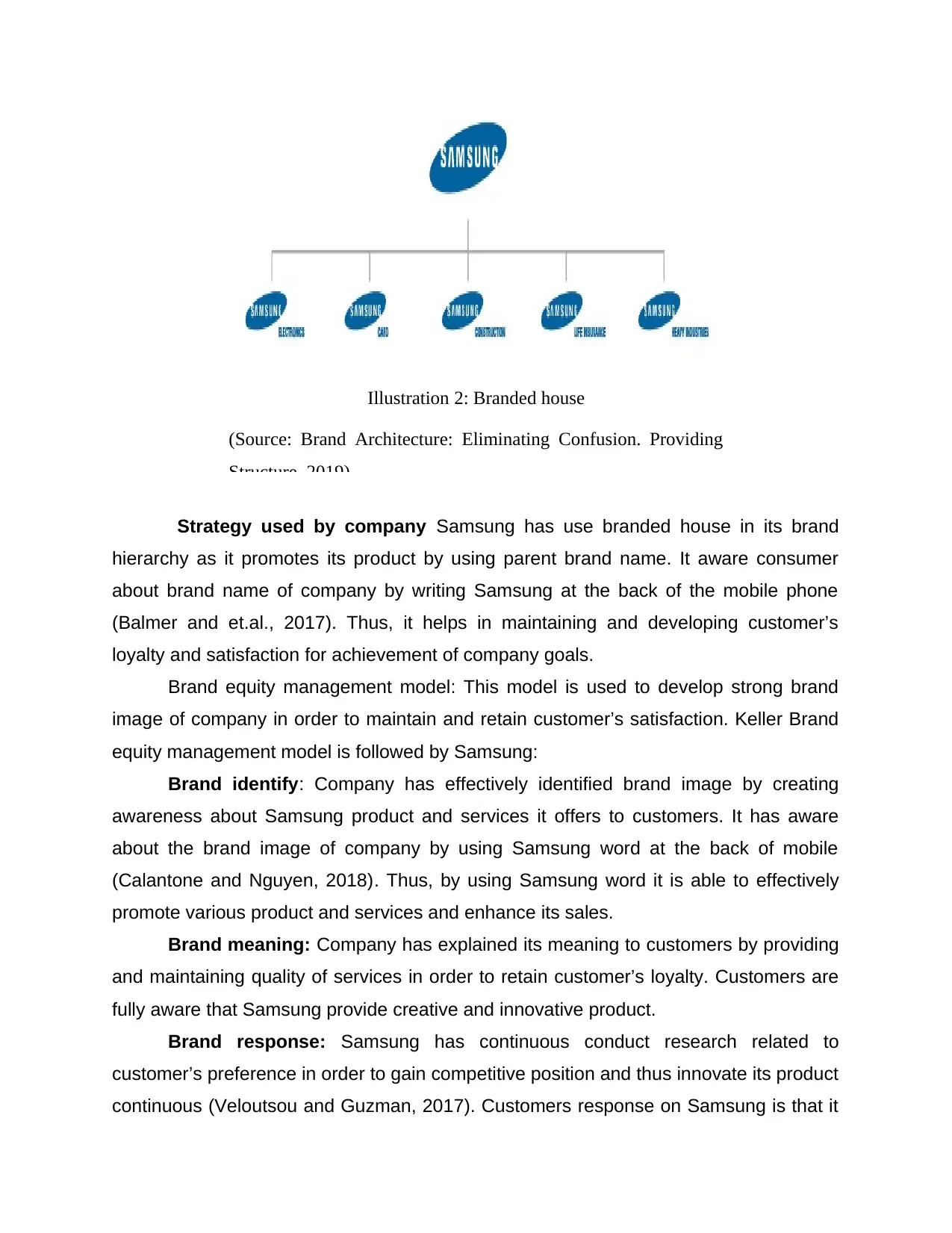
Strategy used by company Samsung has use branded house in its brand
hierarchy as it promotes its product by using parent brand name. It aware consumer
about brand name of company by writing Samsung at the back of the mobile phone
(Balmer and et.al., 2017). Thus, it helps in maintaining and developing customer’s
loyalty and satisfaction for achievement of company goals.
Brand equity management model: This model is used to develop strong brand
image of company in order to maintain and retain customer’s satisfaction. Keller Brand
equity management model is followed by Samsung:
Brand identify: Company has effectively identified brand image by creating
awareness about Samsung product and services it offers to customers. It has aware
about the brand image of company by using Samsung word at the back of mobile
(Calantone and Nguyen, 2018). Thus, by using Samsung word it is able to effectively
promote various product and services and enhance its sales.
Brand meaning: Company has explained its meaning to customers by providing
and maintaining quality of services in order to retain customer’s loyalty. Customers are
fully aware that Samsung provide creative and innovative product.
Brand response: Samsung has continuous conduct research related to
customer’s preference in order to gain competitive position and thus innovate its product
continuous (Veloutsou and Guzman, 2017). Customers response on Samsung is that it
Illustration 2: Branded house
(Source: Brand Architecture: Eliminating Confusion. Providing
Structure. 2019)
hierarchy as it promotes its product by using parent brand name. It aware consumer
about brand name of company by writing Samsung at the back of the mobile phone
(Balmer and et.al., 2017). Thus, it helps in maintaining and developing customer’s
loyalty and satisfaction for achievement of company goals.
Brand equity management model: This model is used to develop strong brand
image of company in order to maintain and retain customer’s satisfaction. Keller Brand
equity management model is followed by Samsung:
Brand identify: Company has effectively identified brand image by creating
awareness about Samsung product and services it offers to customers. It has aware
about the brand image of company by using Samsung word at the back of mobile
(Calantone and Nguyen, 2018). Thus, by using Samsung word it is able to effectively
promote various product and services and enhance its sales.
Brand meaning: Company has explained its meaning to customers by providing
and maintaining quality of services in order to retain customer’s loyalty. Customers are
fully aware that Samsung provide creative and innovative product.
Brand response: Samsung has continuous conduct research related to
customer’s preference in order to gain competitive position and thus innovate its product
continuous (Veloutsou and Guzman, 2017). Customers response on Samsung is that it
Illustration 2: Branded house
(Source: Brand Architecture: Eliminating Confusion. Providing
Structure. 2019)
⊘ This is a preview!⊘
Do you want full access?
Subscribe today to unlock all pages.

Trusted by 1+ million students worldwide
1 out of 20
Related Documents
Your All-in-One AI-Powered Toolkit for Academic Success.
+13062052269
info@desklib.com
Available 24*7 on WhatsApp / Email
![[object Object]](/_next/static/media/star-bottom.7253800d.svg)
Unlock your academic potential
Copyright © 2020–2025 A2Z Services. All Rights Reserved. Developed and managed by ZUCOL.





